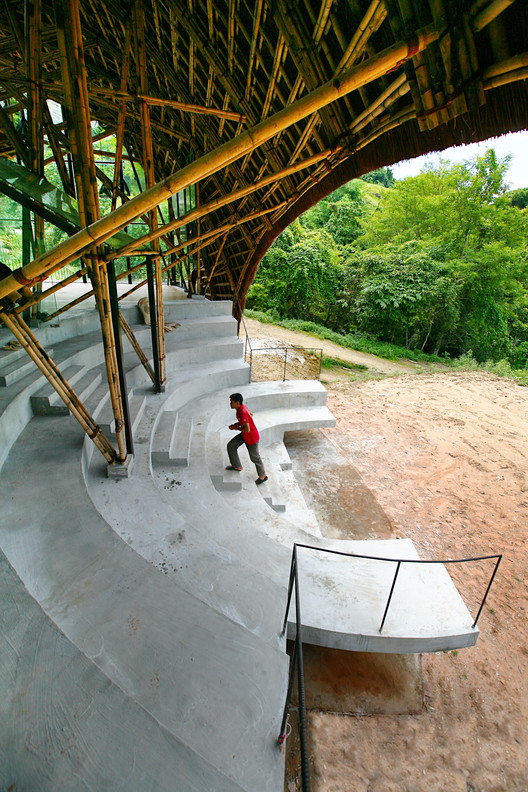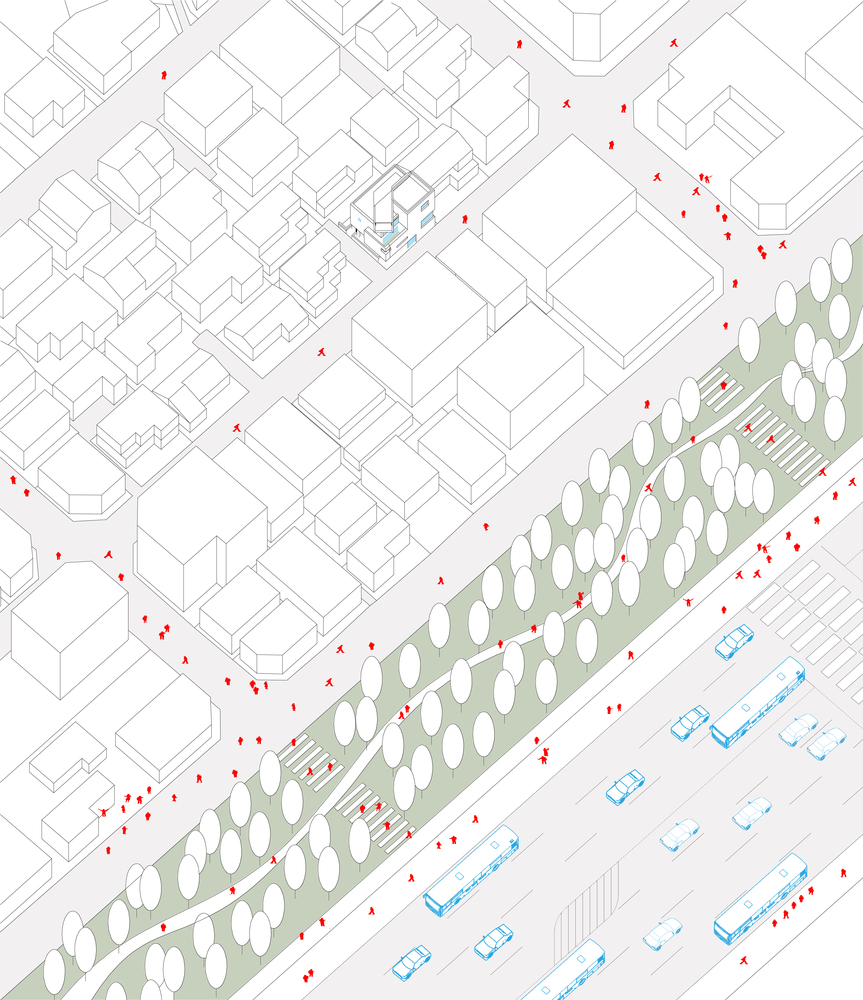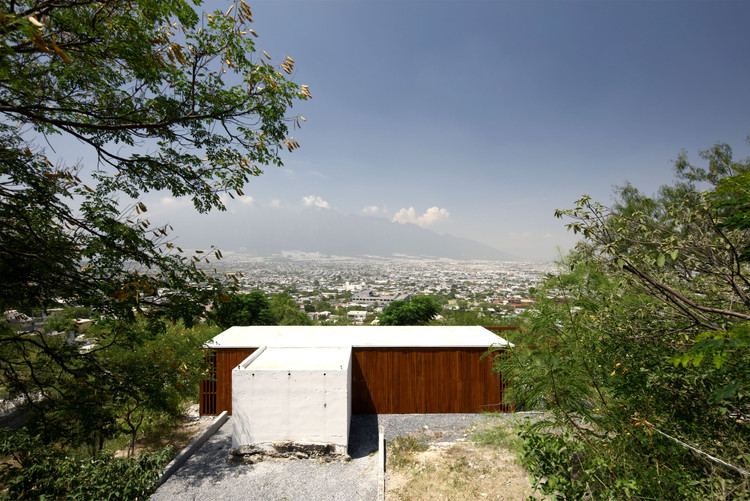Glass House Mountains House Bark Design Architects
2014-04-18 01:00
© Christopher Frederick Jones
克里斯托弗·弗雷德里克·琼斯


© Christopher Frederick Jones
克里斯托弗·弗雷德里克·琼斯


为在罗马尼亚布加勒斯特工作的国际银行业务的澳大利亚外籍客户设计的“玻璃屋山屋”(Glass House Hill House),位于马勒尼(Maleny)的“玻璃屋山庄”(Glass House Hill House)所在地,座落在玻璃屋系列残余边缘的边缘,以及它的本质-“天空与山脉”。翻译成一个“玻璃和石头”的地方,与它的景观有不可分割的联系,它具有锚定,坚固和地面的性质,以及透明,轻和浮动。
Designed for expatriate Australian clients in international banking working in Bucharest, Romania, the ‘Glass House Mountain House’ in Maleny celebrates its site, perched on the edge of the remnant rim of the Glass House range, as well as the essence of its place - ‘sky and mountains’. Translated into a place of ‘glass and stone’ inextricably connected to its landscape it has qualities of being anchored, robust and earthbound as well as being transparent, light and floating.
Ground Floor Plan


令人难忘的是庭院空间的“避难所”,它的边缘由透明的内部空间的室内室外界限所定义,坐落在巨大的玄武岩“花园墙”的避难所和更广阔的自然火山景观之间。与现有的地形,方向,景观和植被,房子平衡经济和精细工艺。
Memorable to the experience is the ‘sanctuary’ of the courtyard space, whose edges are defined by ambiguous indoor outdoor thresholds of the transparent internal spaces, sitting between the refuge of a monumental basalt ‘Garden Wall’ and the broader natural volcanic landscape. Engaging with existing topography, orientation, views and vegetation, the house balances economy and fine craft.
© Christopher Frederick Jones
克里斯托弗·弗雷德里克·琼斯


它庆祝经济的完成,直接,真实性,自然,纹理和未装饰的表面,这是刺绣高工艺木材元素和件。表面、饰面和细节展示了日本人对瓦比山比的概念-不完美、无常和不完整的事物之美,允许随着时间的推移而变化和发展。
It celebrates economical finishes, directness, authenticity, natural, textured and unadorned surfaces which are embroidered with highly crafted timber elements and pieces. Surfaces, finishes and details exhibit the Japanese concept of wabi sabi - the beauty of things imperfect, impermanent and incomplete, allowed to weather and evolve with time.
© Christopher Frederick Jones
克里斯托弗·弗雷德里克·琼斯


可持续性始于自然冷却和照明,利用现有微风和冬季阳光,使用当地来源的硬木、种植的胶合板覆盖层和衬里、再生黑木地板、当地采石场岩石和特有的园林物种。
Sustainability starts with natural cooling and lighting, harnessing available breezes and winter sun, using locally sourced hardwood, plantation grown plywood cladding and lining, recycled Blackbutt timber floors, local quarry rock, and endemic garden species.
在这一地点建立住所是以下列主要原则为指导的:
Establishing habitation on this site has been guided by the key principles of:
© Christopher Frederick Jones
克里斯托弗·弗雷德里克·琼斯


-“锚定”一个人建造的庭院避难所,位于一座巨大的“花园墙”和更广阔的自然火山景观之间。
-‘Anchoring’ a man made courtyard sanctuary between the refuge of a monumental ‘Garden Wall’ and the broader natural volcanic landscape.
-“测绘”特定的山景到和穿过透明的内部空间,把房子内部的空间区域绑在造景的边缘周围,一个私人庭院以躲避天气和道路,同时捕捉北面的冬季阳光。
-‘Mapping’ particular mountain vistas into and through, transparent internal spaces, lacing the internal spatial zones of the house around the edges of a made landscape, a private courtyard to shelter from weather and road whilst capturing Northern aspect for winter sun.
-将“天空和山脉”的现场体验转化为“玻璃和石头”与其景观密不可分的地方。
-Translate the site experience of ‘sky and mountains’ into a place of ‘glass and stone’ inextricably connected to its landscape.
© Christopher Frederick Jones
克里斯托弗·弗雷德里克·琼斯


-锚定、坚固和地面的特性,以及透明、轻盈和漂浮的特性。
-Qualities of being anchored, robust and earthbound as well as transparent, lite and floating.


-表面、饰面和细节展示了日本人的瓦比·萨比思想,它体现了不完美、不持久和不完整的事物的美,这些东西允许随着时间的推移而变化和发展。 公共设施包括更大的景观缓冲和挫折,包括保护街道上的遮荫树,通过建筑物和场地的部分维护公众视野,从下面的山谷,建筑在悬崖上形成和散装的建筑看起来是隐性的和非反射性的,而不是对山脊景观的显性。
-Surfaces, finishes and details exhibit the Japanese idea of wabi sabi as a manifestation of a beauty of things imperfect, impermanent and incomplete which are allowed to weather and evolve with time. Public amenity includes a larger landscape buffer and setback with preservation of shade trees to the street, maintenance of the public view through parts of the building and site, and from the valley below, the buildings form and bulk on the escarpment appears recessive and non reflective rather than dominant to the landscape of the ridge.
© Christopher Frederick Jones
克里斯托弗·弗雷德里克·琼斯


功能简约的要求被划分为不同的空间区域,主室外庭院空间边缘连接的亭子感觉创造了一种连接松散的度假胜地或山庄风格的感觉。
Requirements of the functional brief are separated into distinct spatial zones and the feeling of pavilions connected around the edges of the main outdoor courtyard space creates a loosely connected resort or village feel of a mountain lodge typology.
© Christopher Frederick Jones
克里斯托弗·弗雷德里克·琼斯


造景所必需的是景观建筑学的贡献,以及精心制作的加长石墙,石匠将其演变为个人放置的景观艺术元素,以及精心制作的木结构细木工元素和布艺屏风片艺术家的工艺。
Essential to making Place is the contribution of the landscape architecture, and the fine craft embued Gabion stone wall, which evolved into a personally placed landscape art element by the stone mason, and the crafted timber joinery elements and the craft of the artist of the fabric screen piece.
平衡经济和精细工艺的元素,大部分房子展示经济的饰面,有一定的直观性、真实性、自然、质感和朴素的表面,然后用一些关键的高制作木材元素和木片进行刺绣。
Balancing elements of economy and fine craft, largely the house exhibits economical finishes, a certain directness, authenticity, natural, textured and unadorned surfaces which are then embroidered with some key highly crafted timber elements and pieces.


























































Architects Bark Design Architects
Location Maleny, Australia
Category Houses
Architects in Charge Stephen Guthrie, Lindy Atkin
Project Year 2013
Photographs Christopher Frederick Jones
























